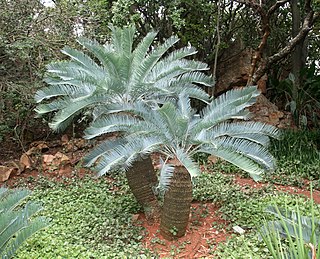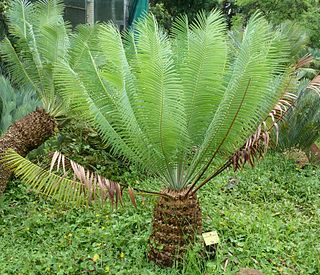
Encephalartos woodii, Wood's cycad, is a rare cycad in the genus Encephalartos, and is endemic to the oNgoye Forest of KwaZulu-Natal, South Africa. It is one of the rarest plants in the world, being extinct in the wild with all specimens being clones of the type. The specific and common name both honour John Medley Wood, curator of the Durban Botanic Garden and director of the Natal Government Herbarium of South Africa, who discovered the plant in 1895.

The Lebombo flat lizard is a species of lizard in the family Cordylidae.

Encephalartos villosus is a South African cycad occurring from the East London vicinity, where it is found near the coast, to the northern border of Eswatini (Swaziland) where it may grow as far as 100 km inland. The species is common throughout its range and is the most frequently cultivated in Southern Africa, largely because of its affordable price. As a result of its large geographical distribution, it is notably variable in leaf and cone shape.

Encephalartos ferox, a member of the family Zamiaceae, is a small cycad with 35 cm wide subterranean trunk. It gets its name from the Latin word ferocious, likely from the spine-tipped lobes on the leaves of the plant. It is found naturally on the south-eastern coast of Africa where it has been used by local people for its starch content. It is considered to be one of the most popular cultivated cycads.

Encephalartos altensteinii is a palm-like cycad in the family Zamiaceae. It is endemic to South Africa. The species name altensteinii commemorates Altenstein, a 19th-century German chancellor and patron of science. It is commonly known as the breadtree, broodboom, Eastern Cape giant cycad or uJobane (Zulu). It is listed as vulnerable due to habitat destruction, use for traditional medicine and removal by collectors.
Encephalartos brevifoliolatus, the escarpment cycad, is a cycad in the African genus Encephalartos. It is extinct in the wild. The escarpment cycad was found in short grasslands in the very open Protea savanna on the northern Drakensberg escarpment in South Africa's Limpopo Province. These plants are used to growing on large cliffs.

Encephalartos ghellinckii Lem. or Drakensberg cycad is endemic to South Africa, and is one of about 70 species found in sub-Saharan Africa. Strongly associated with the Natal Drakensberg, this 3m tall evergreen species is found from the foothills to fairly high altitudes, growing on stream banks, steep grassy slopes and sandstone outcrops. Its preferred habitat lying within grassveld, it has developed resistance to veldfires, and also the intense cold brought on by snow and frost.

Encephalartos lebomboensis is a species of cycad in the family Zamiaceae. Native to the Lebombo Mountains of South Africa, the species was first described in 1949 by the South African botanist Inez Verdoorn. It is commonly known as the Lebombo cycad, although the name is also used for Encephalartos senticosus which also occurs in the same locality.

Encephalartos turneri is a species of cycad that is native to Mozambique. The Encephalartos turneri was discovered by Ian Sutherland Turner in Nampula, Mozambique.

Encephalartos pterogonus is a species of cycad that is native to Mount Mruwere and adjacent mountains in the Manica province of Mozambique.

Encephalartos paucidentatus is a species of cycad.

Encephalartos natalensis, the Natal cycad or giant cycad, is a species of cycad that is endemic to the Qumbu and Tabankulu areas of the northern part of the Eastern Cape, and through most of KwaZulu-Natal. The number of mature individuals of this species is declining and the International Union for Conservation of Nature has assessed its conservation status as being "near threatened".

Encephalartos eugene-maraisii is a species of cycad in the family Zamiaceae. It is endemic to South Africa, where it is limited to Limpopo. It is known as the Waterberg cycad.

Encephalartos laevifolius is a species of cycad that is found in the KwaZulu-Natal, Mpumalanga and Limpopo provinces of South Africa, and at Piggs Peak in Eswatini. The species is facing extinction in the wild, but is widely cultivated. As of 2012, the Encephalartos laevifolius has been listed as critically endangered by the IUCN.

Encephalartos kisambo is a species of cycad in the family Zamiaceae. It is known as the Voi cycad.

Encephalartos inopinus is a species of cycad that is native to Limpopo Province, South Africa.

Encephalartos hirsutus is a species of cycad that is native to Limpopo Province of South Africa. It was recorded from three separate localities on south-east-facing quartzite cliffs in the Makuya Nature Reserve bordering the Kruger National Park at elevations ranging from 800–1,000 meters (2,600–3,300 ft) above sea level.

Encephalartos hildebrandtii is a species of cycad in the Zamiaceae family. It is native to Kenya and Tanzania at elevations from sea level to 600 metres (2,000 ft). The species is named for the German explorer Johann Maria Hildebrandt.

Encephalartos aemulans, the Ngotshe cycad, is a species of cycad endemic to South Africa. It is listed by the IUCN as Critically Endangered and by CITES in Appendix I. Only 100-250 are believed to be left, with a decreasing population trend. Its main threat is collecting of wild specimens.

Encephalartos ngoyanus is a species of cycad in Ngoye Forest, in KwaZulu-Natal, South Africa.
























